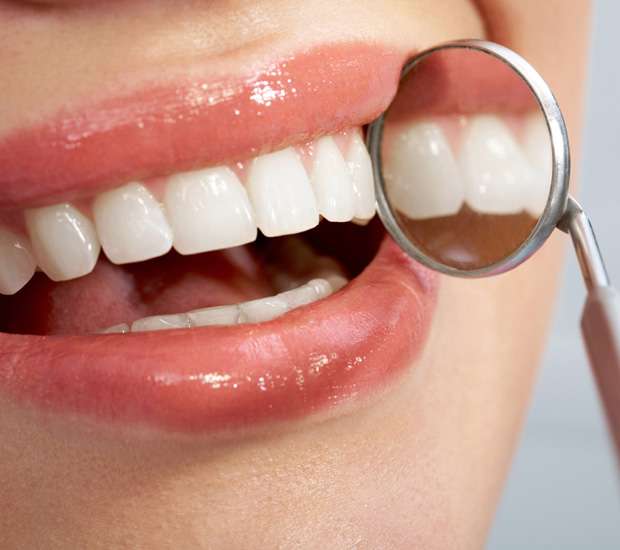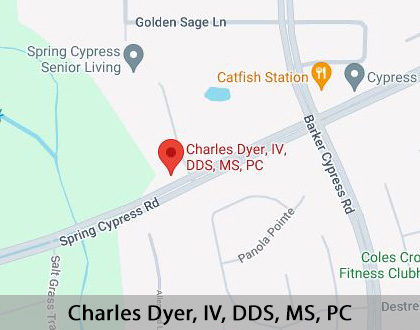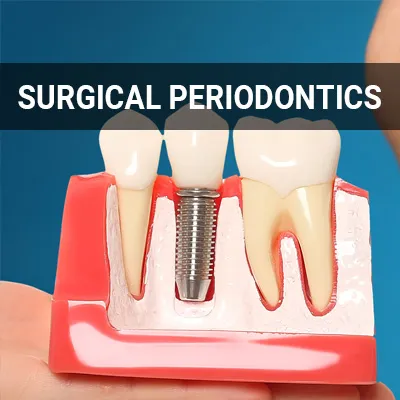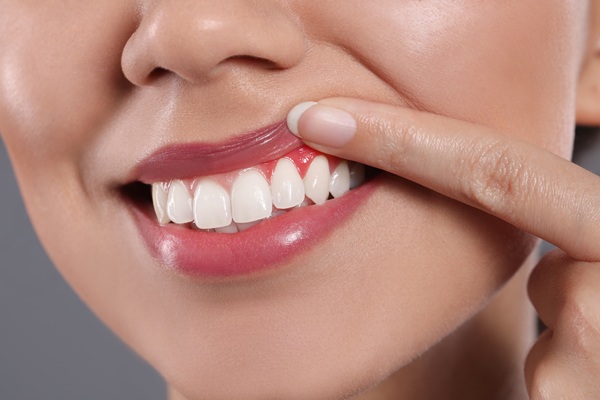Flap Surgery vs. Pocket Reduction Surgery Cypress, TX
Flap surgery and pocket reduction surgery are both generally successful ways of treating advanced gum disease, also known as periodontitis. Flap surgery and pocket reduction surgery both treat and repair periodontal pockets. It is important to know the differences between flap surgery and pocket reduction surgery before deciding which procedure is right for you.
Flap surgery and pocket reduction surgery are available at Charles E. Dyer IV, DDS, MS, PC in Cypress and the surrounding area. We can help determine which surgery is best for you. Call us today at (281) 213-0900 to schedule an appointment or learn more about our services.
What Is Flap Surgery?
Occasionally, periodontitis is too severe to be treated with antibiotics or root planing and scaling. In such cases, a periodontist or gum specialist may need to perform flap surgery. This procedure cleans the tooth roots and repairs bone damage caused by gum disease. Flap surgery begins with the administration of a local anesthetic to numb the targeted area of the gums. The periodontist will then pull back a section of the gums to clean the tooth roots and repair damaged bone as necessary.
Afterward, the practitioner will sew the gum flap back into place and cover it with gauze to stop the bleeding. The bone may be smoothed and reshaped, so there are fewer places for plaque to grow. Alternatively, we may perform a bone graft.
“Occasionally, periodontitis is too severe to be treated with antibiotics or root planing and scaling.”
What Is Pocket Reduction Surgery?
Healthy mouths have less than 2- to 3-millimeter (mm) pockets between the base of the teeth and the gums. These pockets, however, may increase in size due to gum disease. When they become deeper than 5 mm, the area becomes difficult to clean — whether at home or during a professional cleaning by a hygienist. As the pockets get deeper, more bacteria may enter and wear away the gums and bone. If left untreated, these pockets may continue to deepen until the tooth requires extraction.
Pocket reduction surgery, also known as osseous surgery, is meant to eliminate or reduce pockets formed by gum disease. Like other surgeries for gum disease, pocket reduction surgery has a high success rate. The procedure typically takes about two hours and is usually performed by a periodontist. This procedure may also be necessary for patients with severe gum disease or periodontitis that cannot be treated with antibiotics or root planing and scaling. The procedure begins with the administration of a local anesthetic to numb the gums.
The periodontist will make a small incision along the gumline to fold back the gums and remove the bacteria underneath. The periodontist will then smooth down any areas where the bone is irregularly shaped or damaged. A periodontal regeneration technique may be necessary if the bone is severely damaged. The gums are stitched back in place and covered with a periodontal dressing at the end of the procedure.
“Healthy mouths have less than 2- to 3-millimeter (mm) pockets between the base of the teeth and the gums.”
Advantages and Disadvantages of Flap Surgery
Flap surgery can repair the bones damaged by gum disease. If patients maintain good dental care after the surgery, the procedure should allow them to better clean their gums and teeth. Additionally, their gums should return to their normal, healthy, and pink state.
Still, flap surgery is not without its risks. For example, the procedure may cause the tooth roots to become more sensitive or the contour or shape of the gums to change. Gum surgery may also introduce harmful bacteria into the bloodstream and put gum tissue at risk of infection. We will do everything in our power to minimize our patients' chances of risk.
“Flap surgery can repair the bones damaged by gum disease.”
Check out what others are saying about our dental services on Yelp: Flap Surgery vs. Pocket Reduction Surgery in Cypress, TX
Advantages and Disadvantages of Pocket Reduction Surgery
Pocket reduction surgery eliminates any pockets deeper than 5 mm, thus decreasing the likelihood of bacteria and plaque development. Furthermore, it is the most powerful method of treating periodontitis while preserving healthy gum tissue. Pocket reduction surgery also makes it possible for patients to brush areas that were once inaccessible while simultaneously stopping gum bleeding. If the patient keeps a proper oral hygiene routine, the procedure will also significantly reduce the likelihood of a future infection.
However, pocket reduction surgery may also lead to longer-appearing teeth, which some patients do not like. It may make teeth more sensitive, and patients may become more likely to develop root-based cavities in the treated teeth. Keeping a good oral hygiene routine and making regular dentist visits can help protect more vulnerable teeth.
“Pocket reduction surgery eliminates any pockets deeper than 5 mm, thus decreasing the likelihood of bacteria and plaque development.”
Questions Answered on This Page
Q. What happens during flap surgery?
Q. What is the pocket depth for a healthy mouth?
Q. What are the pros and cons of flap surgery?
Q. What are the pros and cons of pocket reduction surgery?
Q. What is it like to recover from a flap surgery or pocket reduction surgery?
People Also Ask
Q. What happens during pocket reduction surgery?
Q. What is surgical periodontics?
Q. What is the gum surgery recovery process like?
Q. What is the purpose of therapeutic treatments for periodontal disease?
Q. What is periodontics? Why is gum health important?
Q. What are the most common signs and symptoms of periodontal tooth loss?
Recovery Period
It typically takes only a few days to recover from a flap surgery or pocket reduction surgery, and it is imperative for patients to follow the at-home instructions given to them by their periodontist. Those who have questions about these instructions should contact their practitioner immediately. Patients should take painkillers as prescribed, keep gauze pads fresh, and relax after surgery.
After 24 hours, patients can gently rinse their mouths with warm salt water several times a day to reduce swelling and relieve pain. It is important to eat soft foods and refrain from lying flat while healing. Patients should also continue to carefully brush their teeth and tongue and refrain from using sucking motions or smoking. Applying an ice or cold pack to the outside of the mouth can also help relieve pain and swelling.
“It typically takes only a few days to recover from a flap surgery or osseous surgery, and it is imperative for patients to follow the at-home instructions given to them by their periodontist.”
Frequently Asked Questions
Q. Will I need to take antibiotics before and after my flap surgery?
A. Possibly. It depends on whether you have a condition that puts you at high risk for severe infection or if infections are especially dangerous for you. If you have certain heart problems, an impaired immune system, have had recent major surgeries, or have man-made body parts, antibiotics may be right for you.
Q. Can gum disease come back after flap surgery or pocket reduction surgery?
A. Yes. Gum disease is most often caused by poor oral hygiene. As such, it is crucial to brush and floss regularly even after getting flap or pocket reduction surgery.
Q. What causes gum disease?
A. Gum disease is caused by an excess of bacteria that appear as a sticky, colorless plaque. If this plaque is not properly removed, it hardens into tartar, which can only be removed by a professional cleaning. As previously mentioned, gum disease is most frequently caused by poor oral hygiene; however, other risk factors include diabetes, hormonal changes in females, medications that lessen saliva flow, certain illnesses and medications, and genetic susceptibility.
Q. What are some alternatives to pocket reduction surgery?
A. Pocket reduction surgery is only recommended in cases where antibiotics or a simple root planing and scaling are not enough. However, other alternatives include bone grafting, soft tissue grafts, and guided tissue regeneration. We will take the time to go over the best treatment options for you.
Q. What is a periodontist?
A. A periodontist is a dentist who specializes in treating the gums. As such, they help prevent, diagnose, and treat gum disease. They are also uniquely qualified to place dental implants.
Start Feeling Better – Visit Us Today
By visiting us as soon as possible, our team can help get you the professional treatment you need. Instead of waiting around and allowing the symptoms to get worse, we can provide you with treatment options.
Definitions
Call Us Today
Do not let gum disease damage your oral health. Let us help. Call us today at (281) 213-0900 to schedule an appointment or learn more about our services.
Helpful Related Links
- American Academy of Periodontology (AAP). American Academy of Periodontology (AAP). 2023
- Center for Disease Control and Prevention (CDC), Periodontal Disease Page. Center for Disease Control and Prevention (CDC), Periodontal Disease Page. 2023
- WebMD, What Is a Periodontist?. WebMD, What Is a Periodontist?. 2023
About our business, license, and website security
- Charles E. Dyer IV, DDS, MS, PC was established in 2007.
- We accept the following payment methods: American Express, Cash, Check, Discover, MasterCard, and Visa
- We serve patients from the following counties: Harris County, Washington County, and Waller County
- We serve patients from the following cities: Cypress, Houston, Katy, Spring, The Woodlands, Brenham, Waller, Sugar Land, Jersey Village, and Hempstead
- TX (License #21174). View License Information and Specifics
- National Provider Identifier Database (1285771352). View NPI Registry Information
- Healthgrades. View Background Information and Reviews
- Norton Safe Web. View Details
- Trend Micro Site Safety Center. View Details
Back to top of Flap Surgery vs. Pocket Reduction Surgery










